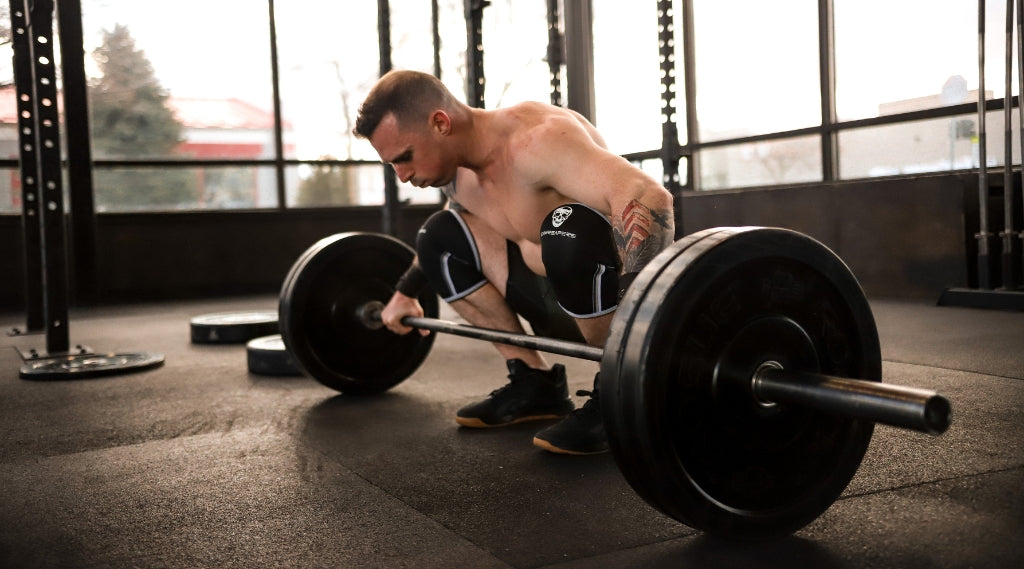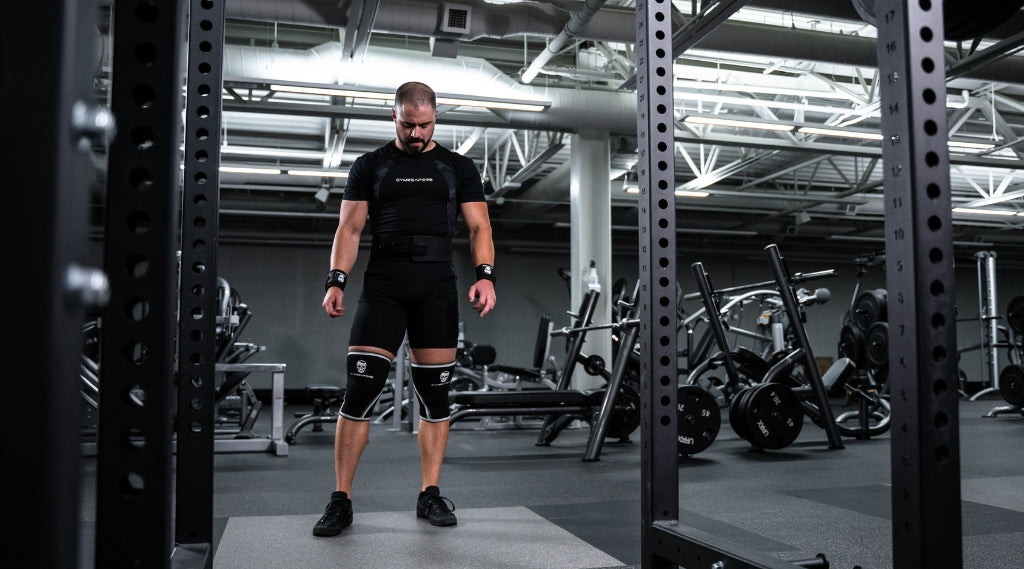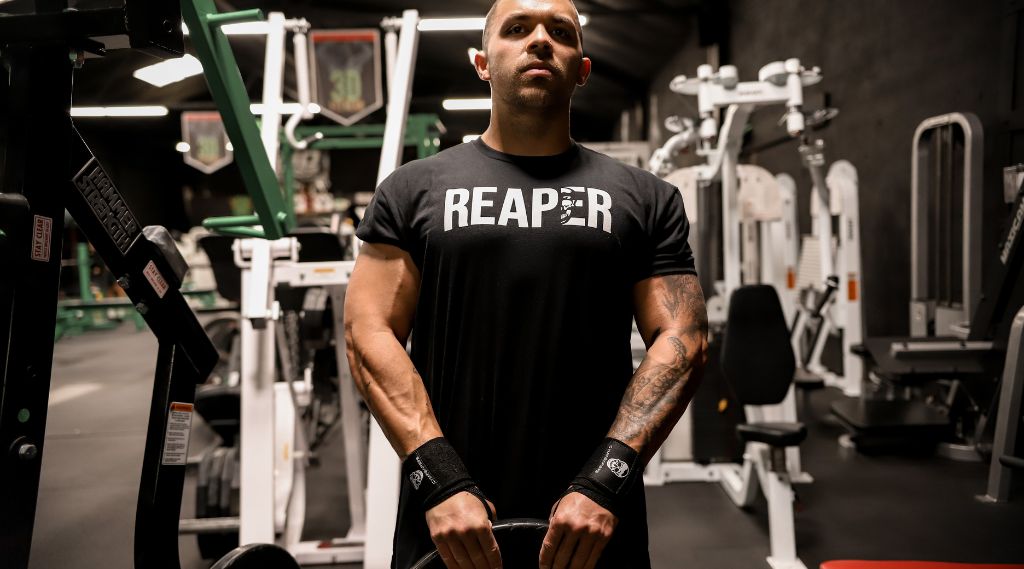The knees are subject to a lot of training stress during Olympic weightlifting and need proper protection to stay healthy. Knee sleeves are one great option to help reduce your risk of injury but it’s important to pick the right ones.
The best knee sleeves for Olympic lifting should be around 7 mm thick to offer joint support without feeling too tight or stiff. Thicker sleeves can obstruct movement and make it challenging to receive the bar in a deep squat. Good sleeves are made of neoprene; a type of rubber that traps heat and keeps the knees warm.
Of course, picking the right sleeves isn’t as simple as finding one that is 7 mm thick, you must also consider several other things to get your money’s worth and reduce the risk of a knee injury.
Key Takeaways
Knee sleeves work by compressing the joint, allowing for a stable and more controlled motion. Sleeves also trap heat, allowing lifters to warm up their knees more quickly.
Good knee sleeves store some potential energy and provide a slight ‘bounce’ out of the bottom position in the snatch and the clean can help boost your performance.
To get the most benefit out of your knee sleeves while weightlifting it's important to purchase a pair that fits properly and won’t wear out easily.
What Is The Purpose Of Knee Sleeves For Olympic Weightlifting?

The purpose of knee sleeves for Olympic weightlifting is to provide joint support, leading to a more stable and comfortable knee position during heavy and dynamic lifts. Like other supportive gear, such as lifting belts and wrist wraps, knee sleeves provide stability through compression.
Sleeves go over your knees, squeezing them in position and allowing for more stability as your knee joint goes through its full range of motion. This level of support can help lifters feel more confident in receiving the bar under heavier loads.
Additionally, given that sleeves are somewhat elastic, they can stretch to a degree and offer a bit of assistance at the bottom position. For instance, as you descend, the sleeves stretch and store potential energy, which can help you bounce out of the squat more quickly.
The final way knee sleeves help during Olympic weightlifting is by providing warmth and increasing blood flow to the knees.
The warmth and blood blow to your knees is beneficial because your knee joint is filled with synovial fluid (a fluid responsible for lubricating the joint, reducing friction, and acting as a shock absorber) which works best at slightly higher temperatures.
Therefore, warming up your knees can be very effective for keeping them healthy and ache-free, especially during your first couple of sets.
What Makes Good Olympic Weightlifting Knee Sleeves?

Thickness
Thickness is the first and most important thing you should consider when purchasing knee sleeves for Olympic lifting.
Knee sleeves generally come in three thickness options: 3mm, 5mm, and 7mm.
The 3mm option is best for those who don’t want any support, and just want to keep the knees somewhat warm between sets.
The 5mm option is best for those who don’t need much support and simply want a sleeve there as a reminder to stay tight and keep the knees warm.
Most olympic lifters would benefit most from the superior support of 7mm knee sleeves. These fit snugly over your knees, provide the most support, and improve confidence under heavy loads.
Length
Most knee sleeves on the market will be long enough to cover the lower part of your thigh and the upper part of your calf; generally, this ends up being a sleeve that is 8 to 10” (25.4 cm) long.
Choosing the right length is important because getting a sleeve that is too short will cause the sleeve to move around while you’re lifting, which compromises the support you would get from the sleeve.
A properly fitting knee sleeve for olympic weightlifting should look like this:
Material
The best knee sleeves on the market for weightlifting are made of neoprene, a strong, elastic material that provides great support. Neoprene, a type of rubber, is also used for making diving wetsuits and is known for its ability to provide insulation and trap heat.
Choosing a knee sleeve made of neoprene will help keep your knees warm and supported better than other materials. Additionally, it’s better at sticking to the skin, allowing knee sleeves to stay in position, and preventing the sleeves from bunching up or sliding down on your legs while training.
Durability
Knee sleeve durability is another thing to consider for weightlifting because low-quality sleeves are prone to wear and tear, especially when dragging the bar up your legs during snatches, cleans, and pulls.
Poor-quality stitching is prone to fraying, which can eventually cause the knee sleeve to come apart. Fraying is more likely to occur when you’re using a high-quality bar that has more aggressive knurling (to improve your grip), so it’s important to choose a knee sleeve that can handle it.
Higher-quality knee sleeves are made with reinforced stitching and come with a warranty so that you don’t have to worry about your sleeves falling apart after only a few uses.
Weightlifting Approved
The final thing to consider is if you plan on competing because if you do have plans to compete then you need to pick a knee sleeve that adheres to the IWF rules, which state:
“One-piece elastic bandages, neoprene / rubberized kneecaps, or patella protectors which allow free movement, may be worn on the knees.”
According to their rules, one-piece neoprene knee sleeves are allowed.
How Do I Choose The Right Size Knee Sleeves For Olympic Weightlifting?

Properly fitting knee sleeves should provide some compression but should not be uncomfortable to wear or cut off circulation. There should be minor resistance when bending your knees to allow for some assistance out of the bottom position but you should not feel restricted.
Additionally, knee sleeves should take some effort to drag over the knees. Being able to pull the sleeves to your knees without much effort likely means they aren’t the right fit and wouldn’t provide enough support. However, they shouldn’t be so tough to put on that you’re out of breath.
The most accurate way to determine what size knee sleeves you need is to borrow a pair from a buddy at the gym to see how they fit. For instance, if they use medium sleeves, but you can’t get them over your calf then you know you need at least a large.
However, the most convenient way would be to reference the size guide that is provided by the knee sleeve manufacturer. The size guide will suggest which size you need based on your measurements.
To measure correctly, extend your leg, wrap the tape measure around your kneecap, and pull it tight enough that there’s no slack but not so tight that it’s squeezing your skin. Take the most accurate value and compare it to the size chart.
For instance, here are the sizing options for the Gymreapers knee sleeves:
- 11.8 to 13” (30 to 33 cm) - small (S)
- 13 to 14.2” (33 to 36 cm) - medium (M)
- 14.2 to 15.7” (36 to 40 cm) - large (L)
- 15.7 to 17” (40 to 44 cm) - extra large (XL)
- 17 to 18.3” (44 to 47 cm) - extra extra large (XXL)
Going for slightly smaller sleeves by sizing down would allow for more compression and support while somewhat limiting the range of motion, whereas going with a larger size would provide less support and more range of motion.
For example, if your knees measure 16”, going for a pair of large ones would provide greater support at the expense of some mobility. Putting them on would also be more challenging, especially as your knees and hands get sweaty.
Most people should stick to their size because they will get the necessary support and maintain the knee range of motion that is required for weightlifting.
Related Article: What to Look for When Buying Olympic Lifting Wrist Wraps
Best Knee Sleeves For Olympic Weightlifting

Our top pick for weightlifting knee sleeves are the Gymreapers 7mm sleeves because of their high-quality design, material, and durability.
Gymreapers 7mm Knee Sleeves
Key Features
- Price: $59.99
- Thickness: 7mm
- Material: premium neoprene
- Stitching: reinforced
- Length: 10” (25.4 cm)
- Sizes: S, M, L, XL, and XXL
- Warranty: a 1-year replacement guarantee
- Reviews: 4.9/5 stars
Our Thoughts
The 7mm knee sleeves from Gymreapers offer the perfect balance between support and mobility, providing lifters with additional stability without restriction so that they feel confident receiving the bar under heavier loads.
“Gymreapers is a solid brand that tops many of our guides to fitness gear. The Gymreapers knee sleeves are available in a 7-millimeter width. Our team determined that for the price, these sleeves are pretty good.”
Thanks to the quality neoprene material, these sleeves provide a contoured fit and keep your knees warm between sets, leading to a more comfortable training experience and injury prevention.
Their reinforced stitching keeps everything together and eliminates the risk of fraying, which is common when weight lifting with lower-quality knee sleeves. If you do experience any issues, there is a 1-year warranty to take advantage of.
The Gymreapers sleeves are 10” long, enough to cover the area from the lower thighs to the upper calves, to provide the best fit possible. There are also five size options to choose from, covering knee circumferences from 11.8” to 18.3” (30 to 47 cm).
They also come in three different colors:
- Black with a white logo, letters, and lines
- Black with a red logo, letters, and lines
- Ranger green with a black logo, letters, and lines
Highlights
- A quality, flexible neoprene material with reinforced stitching that offers the perfect amount of knee support without affecting the joint range of motion
- Able to keep the joints warm, leading to a more comfortable training experience and a lower risk of knee pain
- A length of 10” to cover the knee joint thoroughly and stay in position during dynamic barbell training
- A 1-year warranty to ensure lifters are getting the most out of knee sleeves
Drawbacks
- It can be challenging to put them on once you start to sweat
Related Article: How To Put On Knee Sleeves Properly (According To Expert)
When Should You Wear Knee Sleeves For Olympic Weightlifting?

If You Need Extra Knee Support
Unlike lifting belts, knee sleeves can be worn at any time so you can wear them for main movements (i.e. snatch, clean + jerk, overhead squats) as well as accessory movements (i.e. pulls, lunges, single leg movements).
Some lifters like to put them on during their warm-up whereas others prefer to use them only at higher percentages of their lifts. Whatever works best for you is fine.
Since knee sleeves don’t provide a significant performance boost and are allowed in weightlifting competitions, you don’t have to worry about the frequency of use.
Leave your sleeves in your gym bag if your knees feel great, and put them on if your knees feel stiff or need some support.
If You’re Training In a Cold Environment
If you’re training in a colder environment where it takes longer to warm-up, then it’s worth putting on knee sleeves as soon as you start moving to help your knees warm-up more quickly.
Neoprene sleeves in particular will do a great job of helping your knees warm up and get lubricated, which will encourage better performance in a colder environment.
If You Feel Some Knee Discomfort
It can be normal to experience some knee discomfort when you’re going through a tough training block or having a hard time warming up your joints effectively. In these situations, I would recommend wearing some knee sleeves to help resolve any aches or pains you’re experiencing.
However, if the aches and pains persist even with knee sleeves then you’ve got a bigger issue that you need to address because training through pain can cause minor issues to compound and become worse.
Frequently Asked Questions
Are Knee Sleeves Allowed In Olympic Weightlifting?
Yes, according to the official IWF rules, knee sleeves are allowed as long as they are made of elastic or neoprene. For this reason, the slight bounce that you may get out of the bottom position in the snatch and clean from knee sleeves is not considered cheating.
What Is The Best Material For Knee Sleeves For Weightlifting?
The best material for knee sleeves for weightlifting is neoprene, a type of rubber known for its durability, strength, and ability to trap heat.
Can Wearing Knee Sleeves In Weightlifting Decrease My Risk of Injury?
While there is no evidence that explicitly states that knee sleeves reduce the risk of injury, given their supportive function and ability to keep the knees warm, it’s not a stretch to assume that knee sleeves could reduce the risk, at least to a degree.
That said, training with proper form, using loads you can handle, recovering well, and listening to your body are crucial things that contribute to longevity.
Are Powerlifting And Weightlifting Knee Sleeves The Same?
Yes, the knee sleeves people use for powerlifting are also excellent for weightlifting. Both sports would benefit most from 7mm sleeves that provide more support. Thinner knee sleeves can also provide some support but are generally less beneficial than the 7mm ones.













Leave a comment
All comments are moderated before being published.
This site is protected by hCaptcha and the hCaptcha Privacy Policy and Terms of Service apply.